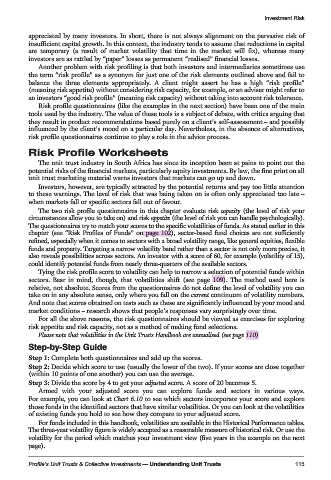Page 117 - Profile's Unit Trusts & Collective Investments - March 2025
P. 117
Investment Risk
appreciated by many investors. In short, there is not always alignment on the pervasive risk of
insufficient capital growth. In this context, the industry tends to assume that reductions in capital
are temporary (a result of market volatility that time in the market will fix), whereas many
investors are as rattled by “paper” losses as permanent “realised” financial losses.
Another problem with risk profiling is that both investors and intermediaries sometimes use
the term “risk profile” as a synonym for just one of the risk elements outlined above and fail to
balance the three elements appropriately. A client might assert he has a high “risk profile”
(meaning risk appetite) without considering risk capacity, for example, or an adviser might refer to
an investors “good risk profile” (meaning risk capacity) without taking into account risk tolerance.
Risk profile questionnaires (like the examples in the next section) have been one of the main
tools used by the industry. The value of these tools is a subject of debate, with critics arguing that
they result in product recommendations based purely on a client’s self-assessment – and possibly
influenced by the client’s mood on a particular day. Nevertheless, in the absence of alternatives,
risk profile questionnaires continue to play a role in the advice process.
Risk Profile Worksheets
The unit trust industry in South Africa has since its inception been at pains to point out the
potential risks of the financial markets, particularly equity investments. By law, the fine print on all
unit trust marketing material warns investors that markets can go up and down.
Investors, however, are typically attracted by the potential returns and pay too little attention
to these warnings. The level of risk that was being taken on is often only appreciated too late –
when markets fall or specific sectors fall out of favour.
The two risk profile questionnaires in this chapter evaluate risk capacity (the level of risk your
circumstances allow you to take on) and risk appetite (the level of risk you can handle psychologically).
The questionnaires try to match your scores to the specific volatilities of funds. As stated earlier in this
chapter (see “Risk Profiles of Funds” on page 102), sector-based fund choices are not sufficiently
refined, especially when it comes to sectors with a broad volatility range, like general equities, flexible
funds and property. Targeting a narrow volatility band rather than a sector is not only more precise, it
also reveals possibilities across sectors. An investor with a score of 60, for example (volatility of 15),
could identify potential funds from nearly three-quarters of the available sectors.
Tying the risk profile score to volatility can help to narrow a selection of potential funds within
sectors. Bear in mind, though, that volatilities shift (see page 109). The method used here is
relative, not absolute. Scores from the questionnaires do not define the level of volatility you can
take on in any absolute sense, only where you fall on the current continuum of volatility numbers.
And note that scores obtained on tests such as these are significantly influenced by your mood and
market conditions – research shows that people’s responses vary surprisingly over time.
For all the above reasons, the risk questionnaires should be viewed as exercises for exploring
risk appetite and risk capacity, not as a method of making fund selections.
Please note that volatilities in the Unit Trusts Handbook are annualised (see page 110)
Step-by-Step Guide
Step 1: Complete both questionnaires and add up the scores.
Step 2: Decide which score to use (usually the lower of the two). If your scores are close together
(within 10 points of one another) you can use the average.
Step 3: Divide the score by 4 to get your adjusted score. A score of 20 becomes 5.
Armed with your adjusted score you can explore funds and sectors in various ways.
For example, you can look at Chart 6.10 to see which sectors incorporate your score and explore
those funds in the identified sectors that have similar volatilities. Or you can look at the volatilities
of existing funds you hold to see how they compare to your adjusted score.
For funds included in this handbook, volatilities are available in the Historical Performance tables.
The three-year volatility figure is widely accepted as a reasonable measure of historical risk. Or use the
volatility for the period which matches your investment view (five years in the example on the next
page).
Profile’s Unit Trusts & Collective Investments — Understanding Unit Trusts 115

